This is a quick and easy recipe for making a shortcrust pastry tart case. It can be used to make sweet or savour recipes as it doesn't contain any sugar.
This quantity of pastry is suitable for an 8inch loose bottomed tart tin with plenty to hang over the sides to allow for shrinkage when resting the pastry and during baking.
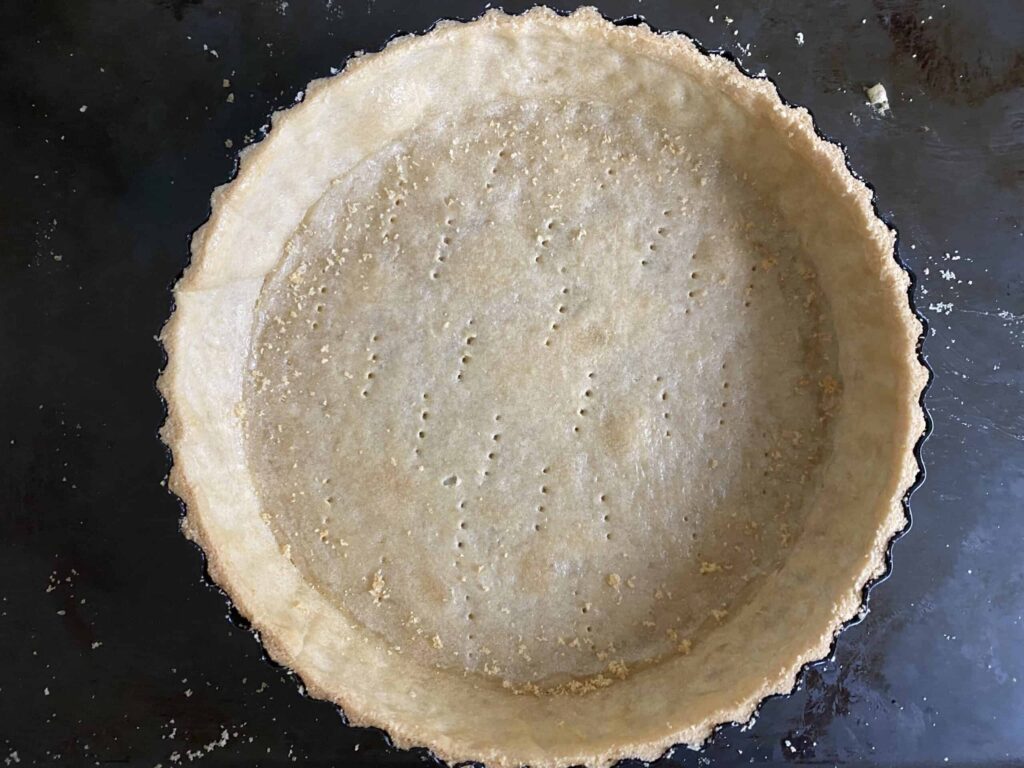
Jump to:
Since taking an online pastry course in early 2020 given by Shirley Quarmby of Sharing Deliciousness, my pastry skills have improved tremendously. I wholeheartedly recommend her course.
Making The Dough
It's easy to feel daunted about making pastry, especially for the first time. Follow these step by step instructions and you won't go wrong. Practice makes perfect. Remember to rest the pastry in the fridge when needed and allow some of the pastry to hang over the sides to allow for shrinkage during baking.
How to Make the Pastry Dough
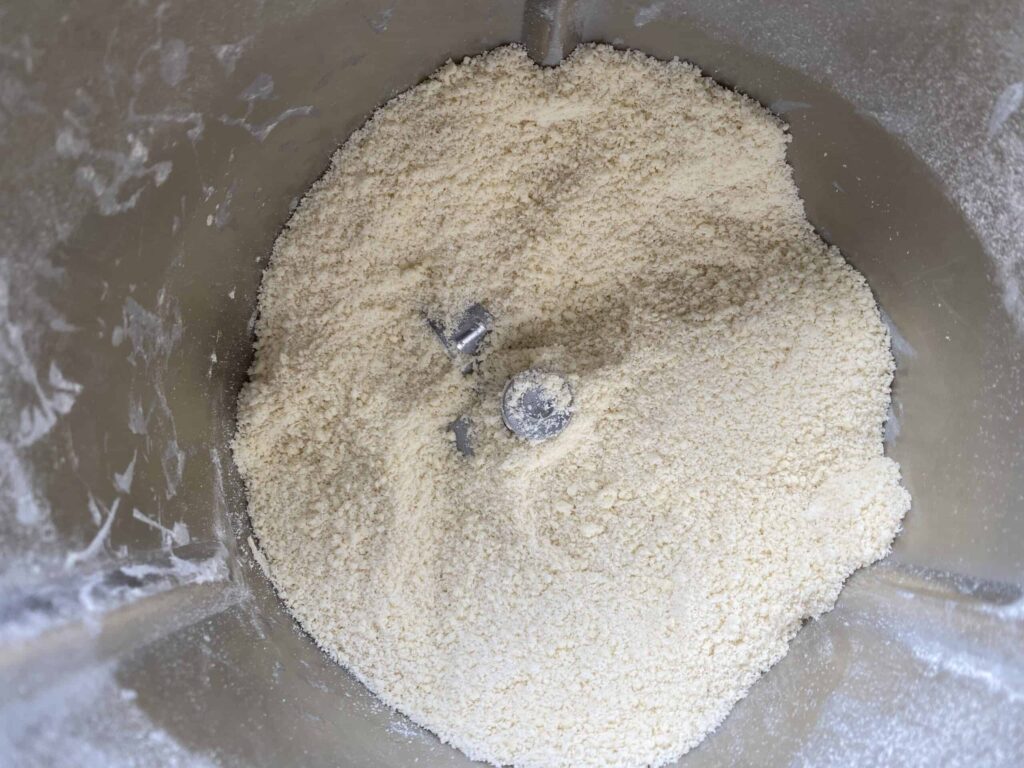
Rub the butter and flour together with your fingertips until you have a fine breadcrumb consistency. For the very best results, use a food processor.
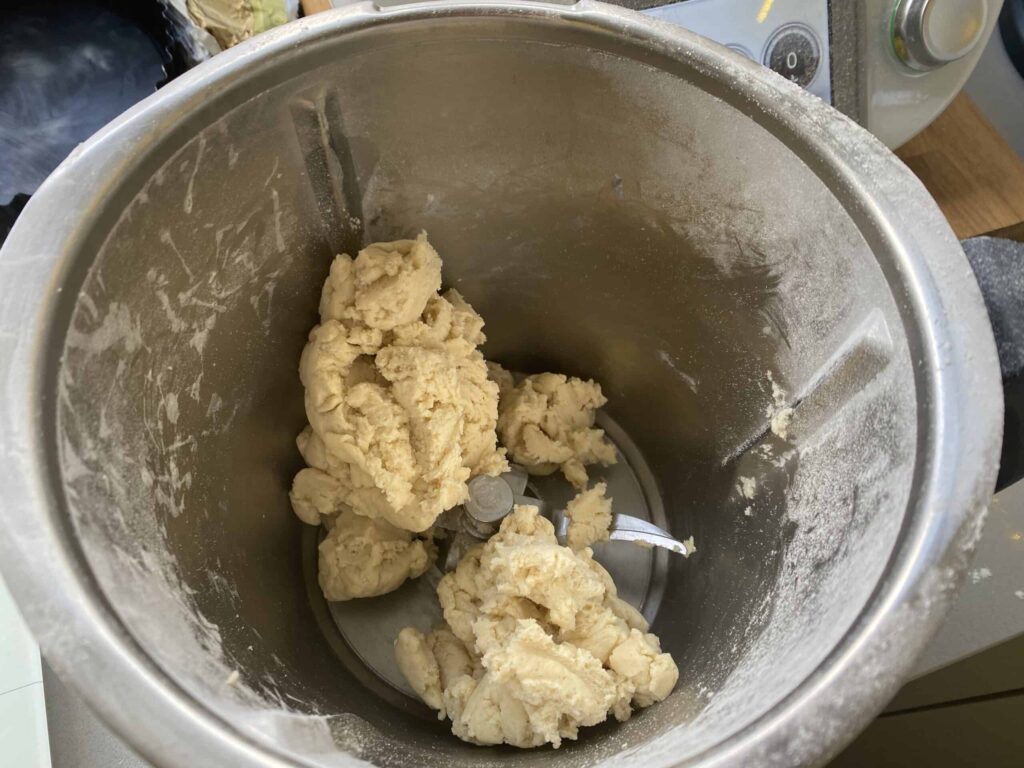
Add the water around the edge of the food processor and blitz until it all comes together into a smooth pastry dough.
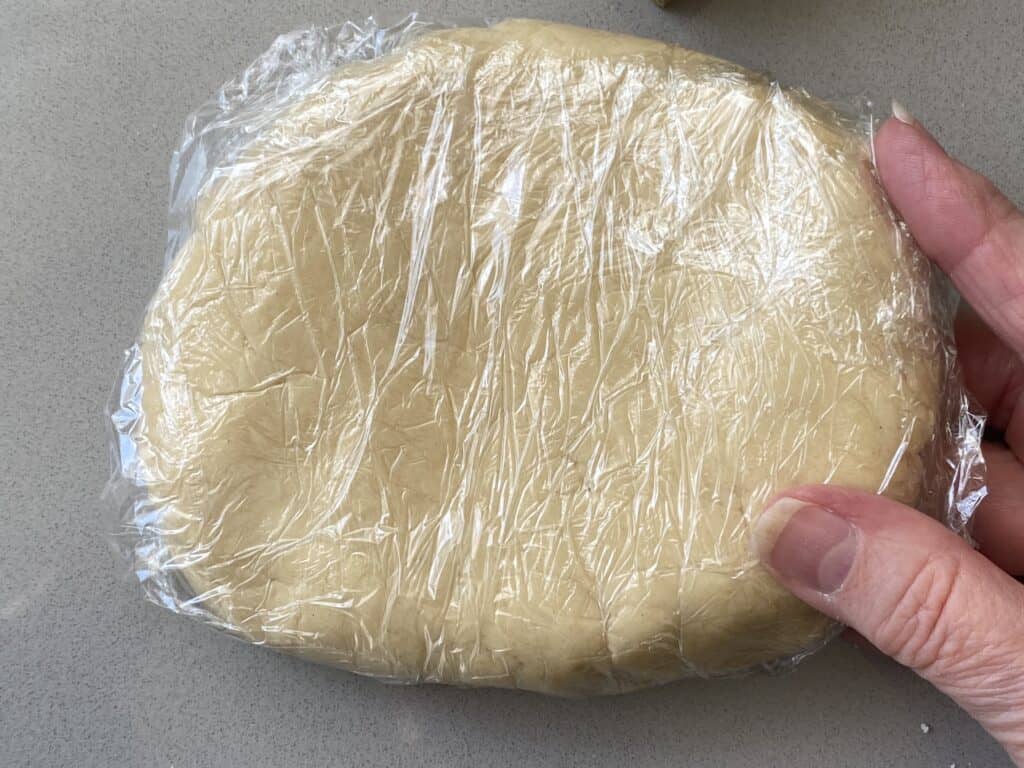
Resting the Dough
Flatten the dough and wrap in cling film. Chill for a minimum of 1 hour in the fridge. This allows the pastry to rest, making it much easier to handle when it comes to lining the tart tin. You can also leave the pastry, wrapped in cling film or baking parchment, in the fridge overnight to use the next day.
Preping the Tart Tin
Preheat the oven to 200 deg (fan oven) Use an oven thermometer to check the correct temperature. Lightly grease the sides and base of a 20cm/8” loose bottomed tart tin about 3cm/1ins deep.
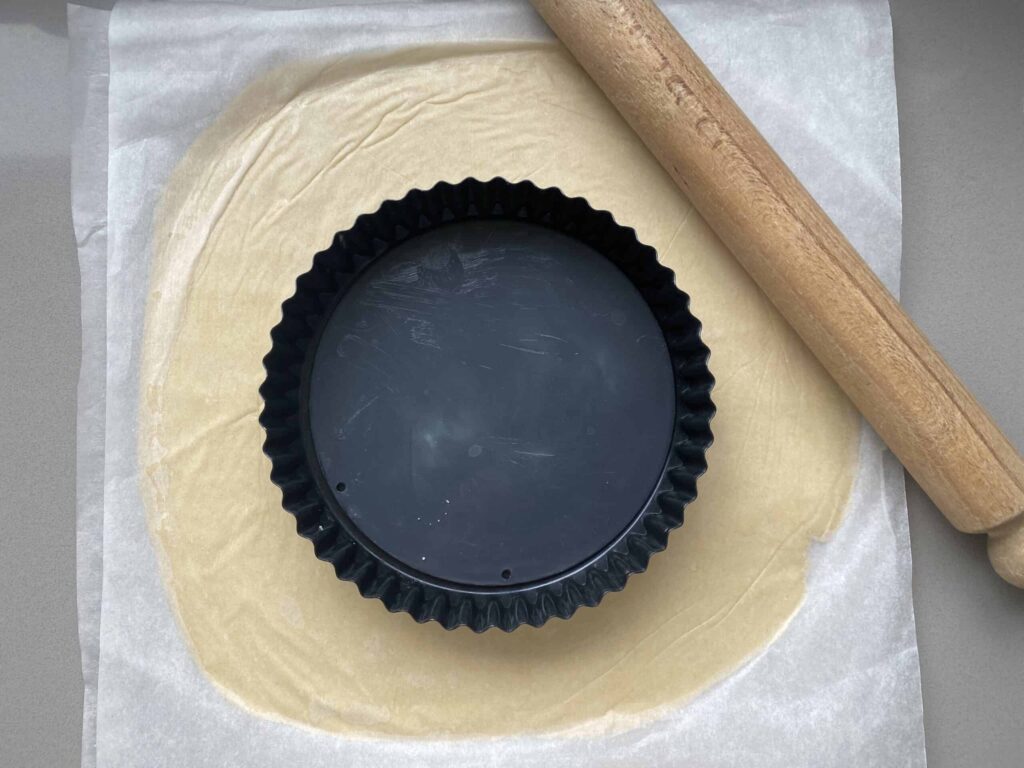
Rolling out the Dough
Take the pastry dough out of the fridge and start to roll between 2 large sheets of baking parchment.
Roll the pastry from the centre outwards turning everything in short circular as you go, until you have a circle that is about 14 inch/36 cm across in diameter and about 2-3 mm thickness, allowing for plenty of pastry to overlap your tart tin.
Top Tip: If your pastry starts to get a little too warm and sticky while rolling, place the whole thing, parchment included, onto a baking sheet, and return to the fridge for 10 minutes or so to firm up a little.
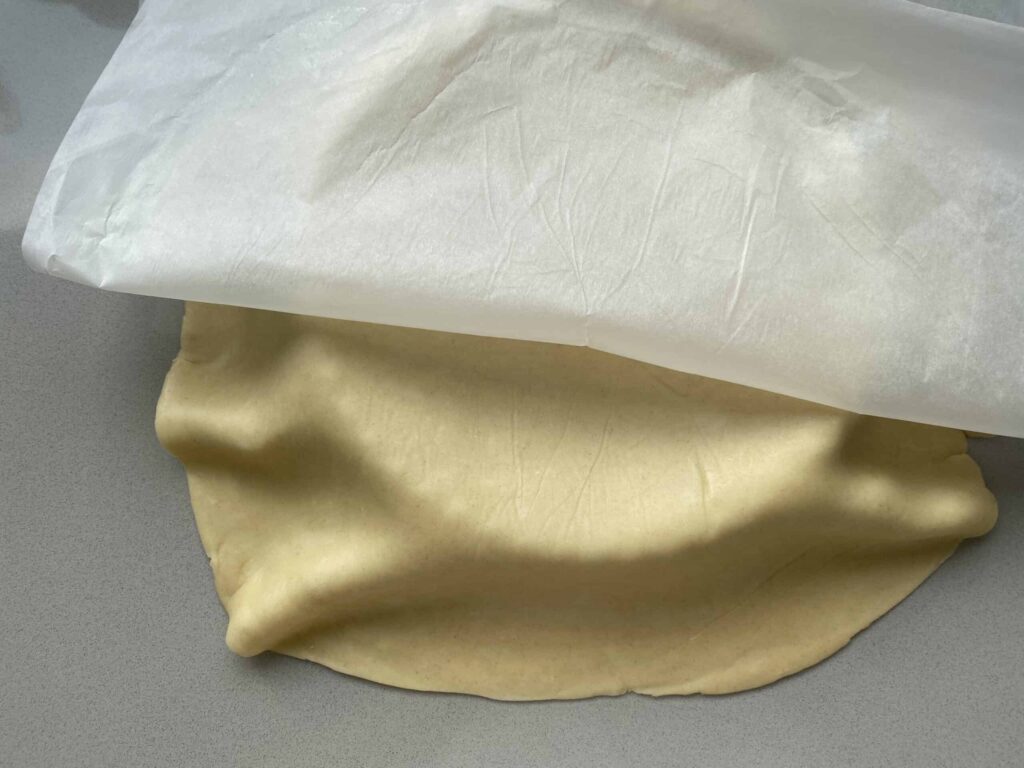
Lining the Tart Tin with Pastry
When you have rolled the pastry out to the correct size and thickness, remove the top sheet of parchment. Invert and place the sheet of pastry dough over the tart tin. Remove the bottom sheet of parchment.

Carefully line the tart tin by lifting and dropping the pastry onto the base and into the sides of the tin. Plenty of overlap will allow for shrinkage during baking.
Cut away any excess pastry that's hanging over the sides of the tart tin. Use a wad of spare pastry, dab with a little flour and gently press the pastry into the sides of the tart tin.
Cover the pastry with a sheet of cling film to help prevent it from drying out, and return it back to the fridge to chill for at least 15 mins. Or you can leave in the fridge overnight to bake the next day.
How to Blind Bake Pastry
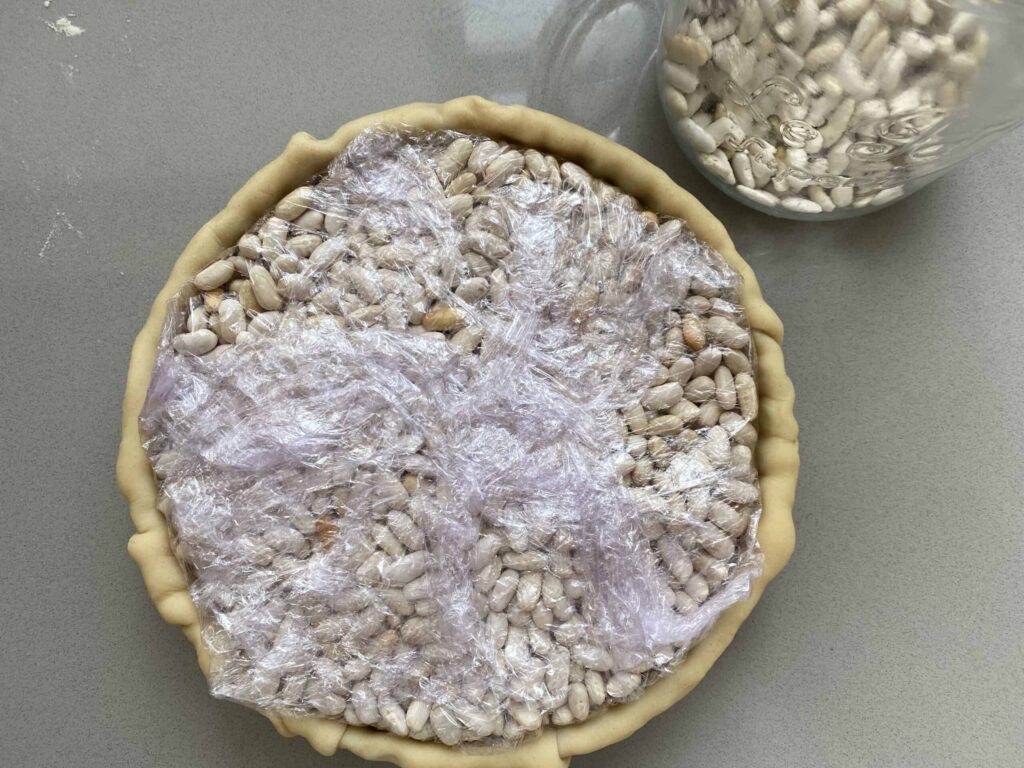
Take the raw pastry tart out for the fridge and carefully prick the base of the pastry dough with a fork. Taking care not to pierce to the bottom.
Line the pastry case with scrunched up baking parchment, or a double sheet of oven safe Industrial Cling Film. DO NOT USE ordinary cling film from the supermarket which will melt.
Fill with plenty of dried rice or dried beans up to the top. This will help keep the pastry in place during baking. Fold the cling film, if using, over the beans to keep them in place.
Bake in the centre of the oven for 20 mins by this time the pastry should be dry and semi baked. If not return to the oven with the baking beans for a further 5 mins.
Remove the baking beans and parchment/cling film and return to the oven for a further 5 mins. The pastry should look dry and ever so slightly golden in colour.
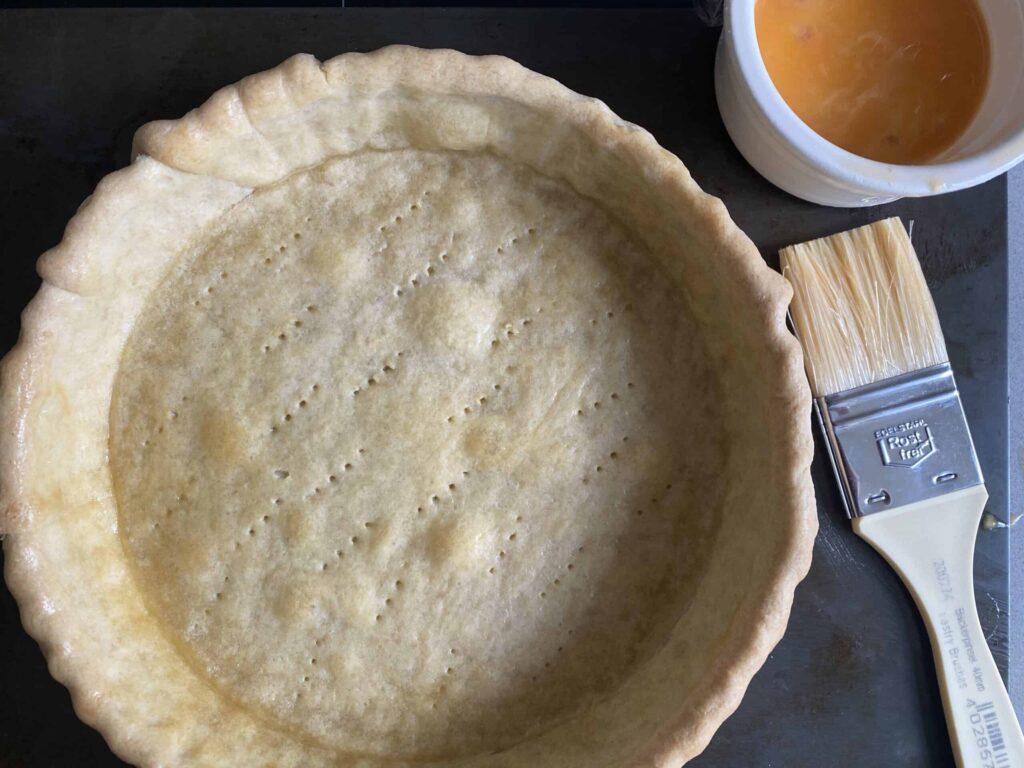
To make the egg wash, thoroughly mix the egg with a splash of water or milk.
Take the baked pastry case out of the oven and coat the base and sides of the pastry case with a very light egg wash. Return to the oven for 1 min to dry off the egg wash.
Top Tip: Rather than waste the remaining egg wash, it will keep in the fridge for a day. Add it to an omelette or do some more pastry making the following day.

Take out of the oven and while still warm, using a serrated knife, slice off any excess pastry that is hanging over the sides.
Use the sides of the tart tin to support the pastry case as you slice off the excess. This helps prevent any pastry from breaking away. Slicing from the inside towards the outside helps achieve clean edges

FAQ's and Top Tips
Do I always need to blind bake pastry?
I prefer to blind bake my shortcrust pastry, especially when adding liquid fillings. It gives a crisp ready cooked base with no soggy bottoms. It also helps cut down the baking times once you've added the filling.
Can I freeze shortcrust pastry dough?
You can freeze shortcrust pastry dough. Wrap in either baking parchment or cling film. Remember to label it to identify which kind of pastry it is.
Bring back to room temperature before starting to roll it out.
How long will shortcrust pastry keep in the fridge?
Shortcrust pastry, when wrapped in baking parchment or cling film will keep in the fridge for a couple of days if you are not going to use it straight away. Any longer than that, you are best freezing it.
What can I use shortcrust pastry for?
This particular recipe doesn't contain any sugar, so you can use it for sweet or savoury tarts.
Can I bake a shortcrust pastry tart in advance?
You can bake a shortcrust pastry tart in advance. It will keep in the fridge for a couple of days before needed. Make sure you wrap it well.
You can also freeze a prebaked shortcrust pastry tart if wrapped well in baking parchment and/or cling film.
- Butter - Butter must be super cold. If you are mixing by hand, try grating the cold butter on to a plate first, pop it in the freezer for a few minutes before adding it to the flour. This will make the rubbing in so much quicker and easier. The butter will stay colder for longer.
- Texture - Don't be tempted to add more water than is needed. If making this by hand using the rubbing in method, the warmth of your hands will also help to bring the dough together.
- Resting the Pastry - Placing the dough in the fridge helps the pastry to relax. It's also easier to handle and cover the tart tin when cold.
Shortcrust Pastry Recipes
Just about every basic tart recipe you see will be made with shortcrust pastry, the fillings are endless.

How to Make Shortcrust Pastry
Equipment
- 8 inch loose bottomed tart tin
INGREDIENTS
- 200 grams plain flour
- Pinch of Salt
- 100 grams unsalted butter very cold and cut into cubes
- 50 grams cold water
For the Egg Wash
- 1 medium egg
- a splash of water or milk
Instructions
MAKE THE SHORTCRUST PASTRY DOUGH
- Rub the butter and flour together with your fingertips until you have a fine breadcrumb consistency. For the very best results, use a food processor.
- Add the water around the edge of the food processor and blitz until you have a smooth pastry dough.
- Bring the pastry dough together, flatten it and wrap in cling film. Chill for a minimum of 1 hour in the fridge. This allows the pastry to settle, making it much easier to handle when it comes to lining the tart tin.
- You can also leave the pastry in the fridge overnight to use the next day.
- Preheat the oven to 200 deg (fan assisted). Use an oven thermometer to check the correct temperature.
- Lightly grease the sides and base of a 20cm/8 inch loose bottomed cake tin about 3cm/1inch deep.
- Take the pastry dough out of the fridge and start to roll between 2 large sheets of baking parchment.
- Roll the pastry from the centre outwards turning everything in short circular turns as you go until you have a circle that is about 14 inch/36 cm across in diameter and about 3 mm thick, allowing for plenty to overlap your tart tin.
- Top Tip: If your pastry starts to get a little too warm and sticky while rolling it, place the whole thing, parchment included, onto a baking sheet and return to the fridge for 5 – 10 minutes or so to firm up a little.
- When you have rolled the pastry out to the correct size, remove the top sheet of parchment. Invert and place the sheet of pastry dough over the tart tin. Remove the bottom sheet of parchment.
- Carefully line the tart tin by lifting and dropping the pastry onto the base and into the sides of tin. Plenty of overlap will allow for shrinkage.
- Cut away any excess pastry that’s hanging over the sides of the tart tin. Use a wad of spare pastry, dab with a little flour and gently press the pastry into the sides of the tart tin.
- Cover the pastry with a sheet of cling film to help prevent it from drying out, and return it back to the fridge to chill for at least 30 mins. Or you can leave in the fridge overnight to bake the next day.
HOW TO BLIND BAKE PASTRY
- Take the raw pastry tart out for the fridge and carefully prick the base of the pastry dough with a fork. Taking care not to pierce the bottom.
- Line the pastry case with scrunched up baking parchment, or a double sheet of oven safe Industrial Cling Film. DO NOT USE ordinary cling film from the supermarket which will melt.
- Fill with plenty of dried rice or dried beans up to the top. This will help keep the pastry in place during baking. Fold the cling film, if using, over the beans to keep them in place.
- Bake in the centre of the oven for 20 mins by this time the pastry should be dry and semi baked. If not return to the oven with the baking beans for a further 5 mins.
- Remove the baking beans and parchment/cling film and return to the oven for a further 5 mins. The pastry should look dry and ever so slightly golden in colour.
- To make the egg wash, thoroughly mix the egg with a splash of water or milk.
- Take the baked pastry case out of the oven and coat the base and sides of the pastry case with a very light egg wash. Return to the oven for 1 min to dry off the egg wash.
- Top Tip: Rather than waste the remaining egg wash, it will keep in the fridge for a day. Add it to an omelette or do some more pastry making the following day.
- Take out of the oven and while still warm, using a serrated knife, slice off any excess pastry that is hanging over the sides.
- Use the sides of the tart tin to support the pastry case as you slice off the excess. This helps prevent any pastry from breaking away. Slicing from the inside towards the outside helps achieve clean edges
Notes
Bring back to room temperature before starting to roll it out. HOW LONG WILL SHORTCRUST PASTRY KEEP IN THE FRIDGE? Shortcrust pastry, when wrapped in baking parchment or cling film will keep in the fridge for a couple of days if you are not going to use it straight away. Any longer than that, you are best freezing it. WHAT CAN I USE SHORTCRUST PASTRY FOR?
This particular recipe doesn’t contain any sugar, so you can use it for sweet or savoury tarts. CAN I BAKE A SHORTCRUST PASTRY TART IN ADVANCE?
You can bake a shortcrust pastry tart in advance. It will keep in the fridge for a couple of days before needed. Make sure you wrap it well. You can also freeze a prebaked shortcrust pastry tart if wrapped well in baking parchment and/or cling film. Butter – Butter must be super cold. If you are mixing by hand, try grating the cold butter on to a plate first, pop it in the freezer for a few minutes before adding it to the flour. This will make the rubbing in so much quicker and easier. The butter will stay colder for longer. Texture – Don’t be tempted to add more water than is needed. If making this by hand, the warmth of your hands will also help to bring the dough together. Resting the Pastry – Placing the dough in the fridge helps the pastry to relax. It’s also easier to handle and cover the tart tin when cold.


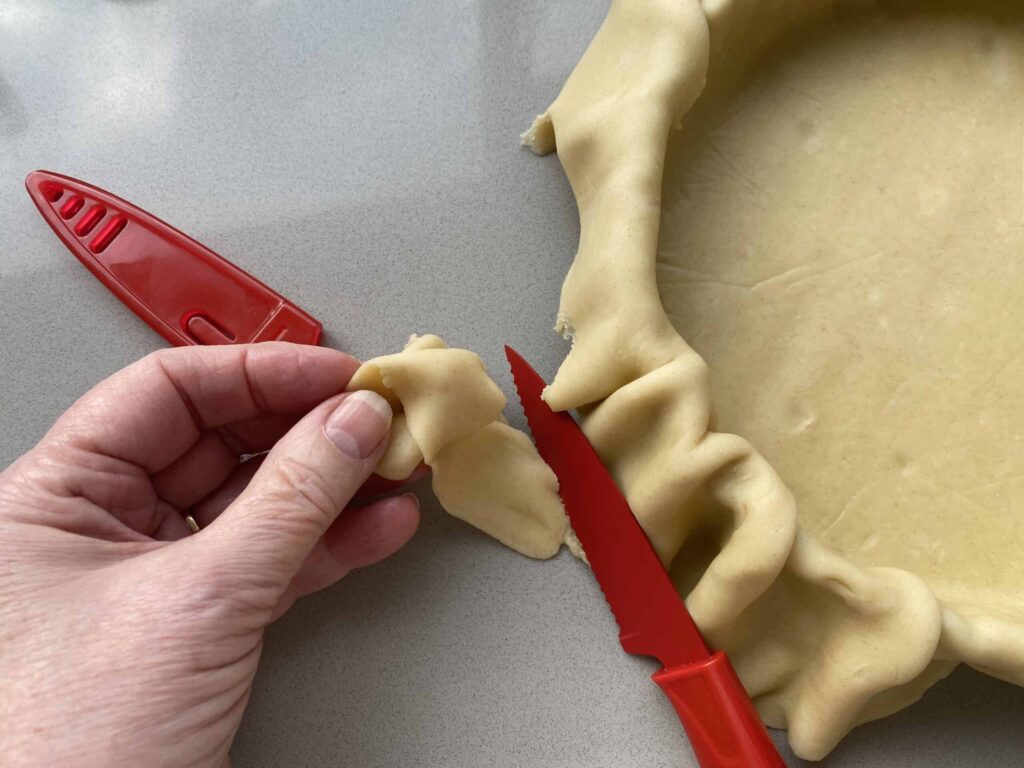
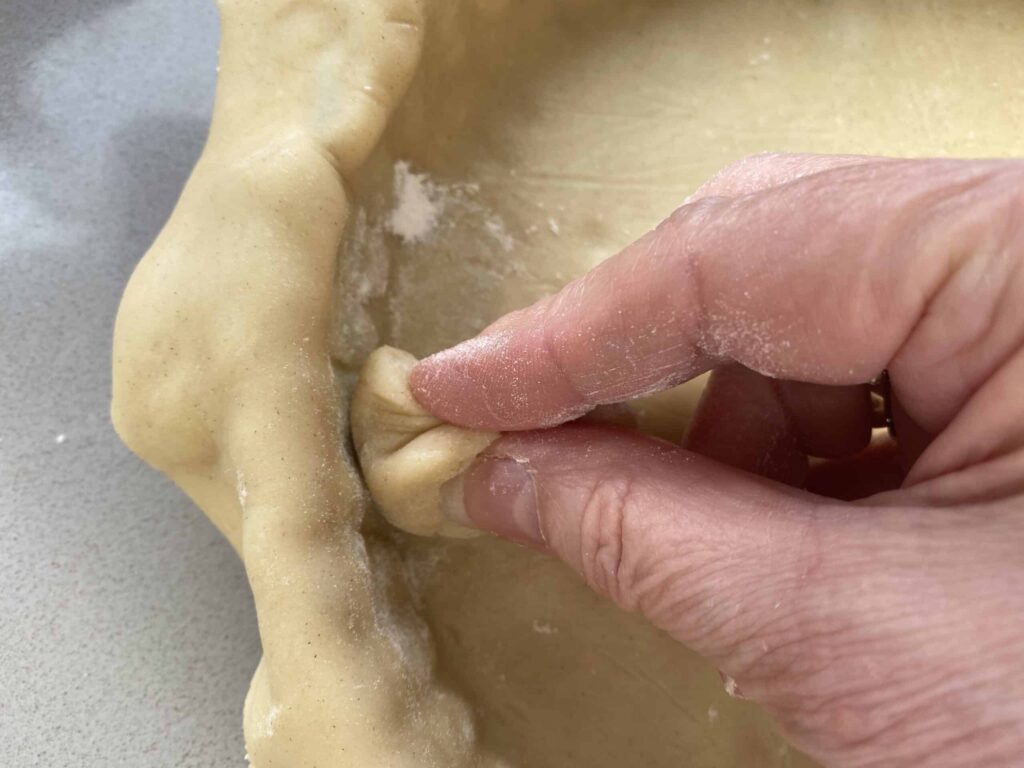
Comments
No Comments